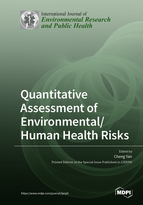Quantitative Assessment of Environmental/Human Health Risks
A special issue of International Journal of Environmental Research and Public Health (ISSN 1660-4601). This special issue belongs to the section "Environmental Health".
Deadline for manuscript submissions: closed (30 September 2022) | Viewed by 22485
Special Issue Editor
Interests: bioaerosol; bioaerosol sensor; airborne microorganisms and biological particles; bio-fluorophore particles; laser induced fluorescence; microbiological contamination in environments; assessment and methodology; public and human health; quantitative microbial risk assessment
Special Issues, Collections and Topics in MDPI journals
Special Issue Information
Dear Colleagues,
An estimated one quarter of death and disease globally is related to environmental hazards (WHO, 2021). From the quality of the air we breathe to the condition of the food we eat, environmental factors can have a significant effect on our health. The environmental factors will evolve due to activities of nature and human beings. Meanwhile, the environmental factors are also a root cause of a significant disease burden of human. Therefore, elaborate assessment of environmental/human health risks are imperative and urgent needed.
The environmental health risks are usually evaluated by the ecological risk assessment which is the process for evaluating how likely it is that the environment might be obstructed as a result of exposure to environmental stressors. Its quantitative assessment steps including: problem formulation, analysis, and risk characterization. The risk assessment of health of human beings is the process to estimate the probability of adverse health effects in humans who may be exposed to contaminated environmental condition. Its quantitative assessment steps including: hazard identification, dose-response assessment, exposure assessment, risk characterization.
Manuscripts addressing these themes are invited for this Special Issue, especially those can deliver novel data on the quantitative assessment framework and provide a theoretical basis for follow-up research on the mitigation measures and control strategies for stakeholders. Findings in manuscripts should be of significant interest to the diverse readership of IJERPH.
Dr. Cheng Yan
Guest Editor
Manuscript Submission Information
Manuscripts should be submitted online at www.mdpi.com by registering and logging in to this website. Once you are registered, click here to go to the submission form. Manuscripts can be submitted until the deadline. All submissions that pass pre-check are peer-reviewed. Accepted papers will be published continuously in the journal (as soon as accepted) and will be listed together on the special issue website. Research articles, review articles as well as short communications are invited. For planned papers, a title and short abstract (about 100 words) can be sent to the Editorial Office for announcement on this website.
Submitted manuscripts should not have been published previously, nor be under consideration for publication elsewhere (except conference proceedings papers). All manuscripts are thoroughly refereed through a single-blind peer-review process. A guide for authors and other relevant information for submission of manuscripts is available on the Instructions for Authors page. International Journal of Environmental Research and Public Health is an international peer-reviewed open access monthly journal published by MDPI.
Please visit the Instructions for Authors page before submitting a manuscript. The Article Processing Charge (APC) for publication in this open access journal is 2500 CHF (Swiss Francs). Submitted papers should be well formatted and use good English. Authors may use MDPI's English editing service prior to publication or during author revisions.
Keywords
- quantitative assessment
- environmental health risks
- human health risks
- problem formulation
- analysis
- hazard identification
- dose-response assessment
- exposure assessment
- risk characterization






